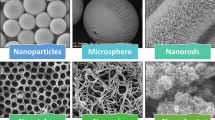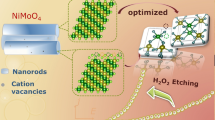Abstract
Despite one-dimensional (1D) semiconductor nanostructure arrays attracting increasing attention due to their many advantages, highly ordered TiO2 nanorod arrays (TiO2 NR) are rarely grown in situ on Ti substrates. Herein, a feasible method to fabricate TiO2 NRs on Ti substrates by using a through-mask anodization process is reported. Self-ordered anodic aluminum oxide (AAO) overlaid on Ti substrate was used as a nanotemplate to induce the growth of TiO2 NRs. The NR length and diameter could be controlled by adjusting anodization parameters such as electrochemical anodization voltage, anodization time and temperature, and electrolyte composition. Furthermore, according to the proposed NR formation mechanism, the anodized Ti ions migrate and deposit in the AAO nanochannels to form Ti(OH)4 or amorphous TiO2 NRs under electric field, owing to the confinement effect of the template. Photoelectrochemical tests indicated that, after hydrogenation, the TiO2 NRs presented higher photocurrent density under simulated sunlight and visible light illuminations, suggesting their potential use in photoelectrochemical water splitting, photocatalysis, solar cells, and sensors.

Similar content being viewed by others
References
Fujishima, A.; Honda, K. Electrochemical photolysis of water at a semiconductor electrode. Nature 1972, 238, 37–38.
Khan, S. U. M.; Al-Shahry, M.; Ingler, W. B. Efficient photochemical water splitting by a chemically modified n-TiO2. Science 2002, 297, 2243–2245.
Chen, X. B.; Liu, L.; Huang, F. Q. Black titanium dioxide (TiO2) nanomaterials. Chem. Soc. Rev. 2015, 44, 1861–1885.
Osterloh, F. E. Inorganic nanostructures for photoelectrochemical and photocatalytic water splitting. Chem. Soc. Rev. 2013, 42, 2294–2320.
Zhang, P.; Zhang, J. J.; Gong, J. L. Tantalum-based semiconductors for solar water splitting. Chem. Soc. Rev. 2014, 43, 4395–4422.
Zhen, C.; Chen, R. Z.; Wang, L. Z.; Liu, G.; Cheng, H.-M. Tantalum (oxy)nitride based photoanodes for solar-driven water oxidation. J. Mater. Chem. A 2016, 4, 2783–2800.
Liu, Y. C.; Gu, Y. S.; Yan, X. Q.; Kang, Z.; Lu, S. N.; Sun, Y. H.; Zhang, Y. Design of sandwich-structured ZnO/ZnS/Au photoanode for enhanced efficiency of photoelectrochemical water splitting. Nano Res. 2015, 8, 2891–2900.
Li, K.; Zeng, X. Q.; Gao, S. M.; Ma, L.; Wang, Q. Y.; Xu, H.; Wang, Z. Y.; Huang, B. B.; Dai, Y.; Lu, J. Ultrasonicassisted pyrolyzation fabrication of reduced SnO2–x /g-C3N4 heterojunctions: Enhance photoelectrochemical and photocatalytic activity under visible LED light irradiation. Nano Res. 2016, 9, 1969–1982.
Roy, P.; Berger, S.; Schmuki, P. TiO2 nanotubes: Synthesis and applications. Angew. Chem., Int. Ed. 2011, 50, 2904–2939.
Wang, G. M.; Wang, H. Y.; Ling, Y. C.; Tang, Y. C.; Yang, X. Y.; Fitzmorris, R. C.; Wang, C. C.; Zhang, J. Z.; Li, Y. Hydrogen-treated TiO2 nanowire arrays for photoelectrochemical water splitting. Nano Lett. 2011, 11, 3026–3033.
Li, S.; Qiu, J. X.; Ling, M.; Peng, F.; Wood, B.; Zhang, S. Q. Photoelectrochemical characterization of hydrogenated TiO2 nanotubes as photoanodes for sensing applications. ACS Appl. Mater. Interfaces 2013, 5, 11129–11135.
Su, F. L.; Wang, T.; Lv, R.; Zhang, J. J.; Zhang, P.; Lu, J. W.; Gong, J. L. Dendritic Au/TiO2nanorod arrays for visiblelight driven photoelectrochemical water splitting. Nanoscale 2013, 5, 9001–9009.
Mor, G. K.; Shankar, K.; Paulose, M.; Varghese, O. K.; Grimes, C. A. Enhanced photocleavage of water using titania nanotube arrays. Nano Lett. 2005, 5, 191–195.
Mor, G. K.; Varghese, O. K.; Paulose, M.; Shankar, K.; Grimes, C. A. A review on highly ordered,vertically oriented TiO2 nanotube arrays: Fabrication, material properties, and solar energy applications. Sol. Energy Mater.Sol. Cells 2006, 90, 2011–2075.
Kang, Q.; Cao, J. Y.; Zhang, Y. J.; Liu, L. Q.; Xu, H.; Ye, J. H. Reduced TiO2 nanotube arrays for photoelectrochemical water splitting. J. Mater. Chem. A 2013, 1, 5766–5774.
Yan, M. C.; Chen, F.; Zhang, J. L.; Anpo, M. Preparation of controllable crystalline titania and study on the photocatalytic properties. J. Phys. Chem. B 2005, 109, 8673–8678.
Liu, H. Y.; Joo, J. B.; Dahl, M.; Fu, L. S.; Zeng, Z. Z.; Yin, Y. D. Crystallinity control of TiO2 hollow shells through resin-protected calcination for enhanced photocatalytic activity. Energy Environ. Sci. 2015, 8, 286–296.
Wang, X. D.; Li, Z. D.; Shi, J.; Yu, Y. H. One-dimensional titanium dioxide nanomaterials: Nanowires, nanorods, and nanobelts. Chem. Rev. 2014, 114, 9346–9384.
Attar, A. S.; Ghamsari, M. S.; Hajiesmaeilbaigi, F.; Mirdamadi, S.; Katagiri, K.; Koumoto, K. Sol–gel template synthesis and characterization of aligned anatase-TiO2 nanorod arrays with different diameter. Mater. Chem. Phys. 2009, 113, 856–860.
Cui, H. L.; Zhao, W.; Yang, C. Y.; Yin, H.; Lin, T. Q.; Shan, Y. F.; Xie, Y.; Gu, H.; Huang, F. Q. Black TiO2 nanotube arrays for high-efficiency photoelectrochemical water-splitting. J. Mater. Chem. A 2014, 2, 8612–8616.
Liu, B.; Aydil, E. S. Growth of oriented single-crystalline rutile TiO2 nanorods on transparent conducting substrates for dye-sensitized solar cells. J. Am. Chem. Soc. 2009, 131, 3985–3990.
Lee, K.; Mazare, A.; Schmuki, P. One-dimensional titanium dioxide nanomaterials: Nanotubes. Chem. Rev. 2014, 114, 9385–9454.
Yun, H.; Lin, C. J.; Li, J.; Wang, J. R.; Chen, H. B. Lowtemperature hydrothermal formation of a net-like structured TiO2 film and its performance of photogenerated cathode protection. Appl. Surf. Sci. 2008, 255, 2113–2117.
Lin, Z.-H.; Xie, Y. N.; Yang, Y.; Wang, S. H.; Zhu, G.; Wang, Z. L. Enhanced triboelectric nanogenerators and triboelectric nanosensor using chemically modified TiO2 nanomaterials. ACS Nano 2013, 7, 4554–4560.
Rahman, M. A.; Bazargan, S.; Srivastava, S.; Wang, X. Y.; Abd-Ellah, M.; Thomas, J. P.; Heinig, N. F.; Pradhan, D.; Leung, K. T. Defect-rich decorated TiO2 nanowires for super-efficient photoelectrochemical water splitting driven by visible light. Energy Environ. Sci. 2015, 8, 3363–3373.
Xu, Y. F.; Zhang, C.; Zhang, L. X.; Zhang, X. H; Yao, H. L.; Shi, J. L. Pd-catalyzed instant hydrogenation of TiO2 with enhanced photocatalytic performance. Energy Environ. Sci. 2016, 9, 2410–2417.
Li, Y. B.; Takata, T.; Cha, D.; Takanabe, K.; Minegishi, T.; Kubota, J.; Domen, K. Vertically aligned Ta3N5 nanorod arrays for solar-driven photoelectrochemical water splitting. Adv. Mater. 2013, 25, 125–131.
Chang, Y. H.; Lin, H. W.; Chen, C. Growth mechanism of self-assembled TiO2 nanorod arrays on Si substrates fabricated by Ti anodization. J. Electrochem. Soc. 2012,159, D512–D517.
Wang, D. A.; Yu, B.; Wang, C. W.; Zhou, F.; Liu, W. M. A novel protocol toward perfect alignment of anodized TiO2 nanotubes. Adv. Mater. 2009, 21, 1964–1967.
Li, Y. B.; Zhang, L.; Torres-Pardo, A.; González-Calbet, J. M.; Ma, Y. H.; Oleynikov, P.; Terasaki, O.; Asahina, S.; Shima, M.; Cha, D. et al. Cobalt phosphate-modified barium-doped tantalum nitride nanorodphotoanode with 1.5% solar energy conversion efficiency. Nat. Commun. 2013, 4, 2566.
Wang, D. A.; Zhang, L. B.; Lee, W.; Knez, M.; Liu, L. F. Novel three-dimensional nanoporous alumina as a template for hierarchical TiO2 nanotube arrays. Small 2013, 9, 1025–1029.
Ruan, C. M.; Paulose, M.; Varghese, O. K.; Mor, G. K.; Grimes, C. A. Fabrication of highly ordered TiO2 nanotube arrays using an organic electrolyte. J. Phys. Chem. B 2005, 109, 15754–15759.
Shankar, K.; Mor, G. K.; Fitzgerald, A.; Grimes, C. A. Cation effect on the electrochemical formation of very high aspect ratio TiO2 nanotube arrays in formamide-water mixtures. J. Phys. Chem. C 2007, 111, 21–26.
Paulose, M.; Shankar, K.; Yoriya, S.; Prakasam, H. E.; Varghese, O. K.; Mor, G. K.; Latempa, T. A.; Fitzgerald, A.; Grimes, C. A. Anodic growth of highly ordered TiO2 nanotube arrays to 134 µm in length. J. Phys. Chem. B 2006, 110, 16179–16184.
Mozalev, A.; Khatko, V.; Bittencourt, C.; Hassel, A. W.; Gorokh, G.; Llobet, E.; Correig, X. Nanostructured columnlike tungsten oxide film by anodizing Al/W/Ti layers on Si. Chem. Mater. 2008, 20, 6482–6493.
Chu, S. Z.; Inoue, S.; Wada, K.; Hishita, S.; Kurashima, K. A new electrochemical lithography: Fabrication of selforganized titania nanostructures on glass by combined anodization. J. Electrochem. Soc. 2005, 152, B116–B124.
Wang, D. A.; Liu, Y.; Yu, B.; Zhou, F.; Liu, W. M. TiO2 nanotubes with tunable morphology, diameter, and length: Synthesis and photo-electrical/catalytic performance. Chem. Mater. 2009, 21, 1198–1206.
Chen, X. B.; Liu, L.; Yu, P. Y.; Mao, S. S. Increasing solar absorption for photocatalysis with black hydrogenated titanium dioxide nanocrystals. Science 2011, 331, 746–50.
Xia, T.; Zhang, C.; Oyler, N. A.; Chen, X. B. Hydrogenated TiO2 nanocrystals: Anovel microwave absorbing material. Adv. Mater. 2013, 25, 6905–6910.
Acknowledgements
Thanks for the financial support of the National Natural Science Foundation of China (Nos. 21303227, 21573259, and 51403220), Qingdao science and technology plan application foundation research project (No. 14-2-4-60-JCH) and the “Hundred Talents Program” of Chinese Academy of Sciences (D. Wang).
Author information
Authors and Affiliations
Corresponding author
Electronic supplementary material
Rights and permissions
About this article
Cite this article
Zhang, T., Rahman, Z.U., Wei, N. et al. In situ growth of single-crystal TiO2 nanorod arrays on Ti substrate: Controllable synthesis and photoelectro-chemical water splitting. Nano Res. 10, 1021–1032 (2017). https://doi.org/10.1007/s12274-016-1361-x
Received:
Revised:
Accepted:
Published:
Issue Date:
DOI: https://doi.org/10.1007/s12274-016-1361-x




